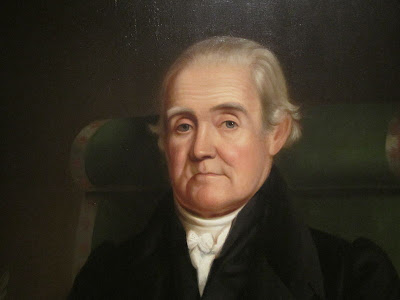One of the archetypal images of New England is the white steepled church standing next to the town common. These churches can be seen all over the region, and are a testament to early settlers' devotion to Christianity.
Sometimes, though, a little bit of paganism crept in, as this story illustrates.
On June 10 in the year 1776 the British ship Bombrig was captured by American naval forces in Long Island Sound. Four of the ship's crew were sent to a crude jail in Windham, Connecticut.
The four men were Edward Sneyd, the ship's commander; John Coggin, the ship's Irish boatswain, who supervised the deck crew; John Russell, the ship's carpenter; and a fourth sailor named William Cook. Although the men were not tortured or particularly mistreated, prisons and jails in the 18th century were grim places where prisoners were confined in small, poorly ventilated cells and fed poorly.
Luckily for the sailors, the owner of a tavern on the other side of Windham's Green (the town common) took pity on them and provided them with good food and plenty of alcohol. Very little is known about the owner except her name - Widow Carey. Who Mr. Carey was and how he passed away is unknown. History is also mute about why she acted so charitably towards the prisoners, but it doesn't take much imagination to guess why a lonely woman might be drawn to four needy sailors. Some people just love a man in uniform!
To repay Widow Carey's charity the sailors asked their wardens for a large log, which they were given. Using just their jackknives they carved from it an image of Bacchus, the Roman god of wine.
 |
| The Windham Bacchus |
Roughly two feet tall, the Windham Bacchus portrays the god as a naked chubby man astride a keg of wine. Bacchus holds a bowl of grapes and apples in front of his unmentionables, and he has chubby cheeks and a big smile. Widow Carey accepted the carving from the sailors and mounted it in front of her tavern.
In November the sailors escaped from Windham's jail and made their way to Norwich, Connecticut, where they stole a canoe. While paddling their way towards Long Island, the canoe capsized and Sneyd, Russell and Cook drowned. John Coggin survived but was recaptured.
The sailors met a grim fate, but their masterpiece lived on. Widow Carey kept it in front of her tavern for many years, until she married another tavern owner and moved it to his establishment. From there Bacchus was sold in 1827 to Lucius Albee, who ran the Staniford House tavern. Albee hung Bacchus from a giant elm tree, where it remained for many years until a large storm blew the sculpture down, breaking one of its arms. After languishing in a woodshed Bacchus was purchased for twenty-five cents, repaired, and celebrated as an iconic image from the Revolutionary War. You can now see it (or should I say him?) in the Windham Free Library.
I like to read about ancient Greco-Roman religion, so this story made my antennas perk up. I don't know much about the history of New England taverns, but it's interesting that tavern owners in Puritan-founded Connecticut would exhibit a statue of a pagan god. It's also interesting how the historical events surrounding the carving parallel ancient Bacchic myths and rituals.
Bacchus is the Roman name for Dionysos, the primordial god of wine and ecstasy. It makes sense for him to be associated with a tavern, but what about those British sailors? Dionysos was associated with water and the sea, and in some Greek rituals a statue of the god was pulled through the streets in a wagon shaped like a ship. In many myths Dionysos seeks refuge in the sea from his oppressors, and also emerges from it to triumph over his enemies. In one famous myth, Dionysos is kidnapped by sailors who want to sell him into slavery. He transforms them into dolphins and they leap into the sea.
Dionysos was also associated with trees and even was addressed as
Dionysos Dendrites ("Dionysos of the Trees"). Paintings from Greece show people worshiping his image attached to a tree, and he also guarded orchards. It's only fitting that Lucius Albee hung him from an elm.
Unfortunately there is a dark side to many of Dionysian myths. People who introduced his worship into an area or city often died by drowning, much like the sailors. For example, Dionysos taught Icarius of Athens to make wine, but Icarius was drowned in a well by drunken shepherds who erroneously thought he poisoned them. As an infant Dionysos was nursed by his aunt Ino, but she was driven mad by the jealous goddess Hera and drowned herself and her son Melicertes in the sea. At the god's sanctuary in Lerna a lamb was thrown into an allegedly bottomless lake as an offering to underworld deities.
Was there some supernatural or divine force at work in 18th century Windham? I don't want to speculate too much. After all I don't want to sound
too paranoid. Maybe historic events just sometimes follow ancient mythic patterns.
On the other hand, there was an actual Bacchus cult in Windham County in the 19th century. But that's my post for next week!
************************
I got my information from
History of Windham County, Connecticut (1889) by Richard Bayles, and
The Story of Bacchus (1876) by Brigham Payne, William Lawton Weaver, and Samuel Peters.







